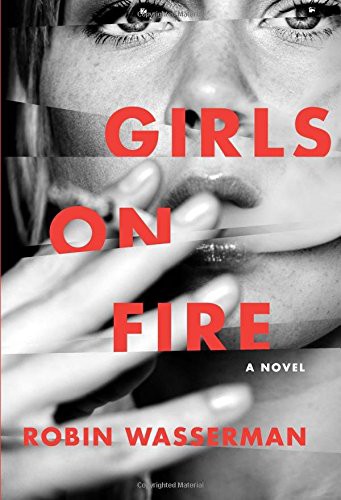Girlhood Against Convention: Why We Can’t Look Away
Robin Wasserman’s ‘Girls on Fire’ and Emma Cline’s ‘The Girls’

Morgan Geyser celebrated her twelfth birthday with a sleepover party on May 30, 2014 in Waukesha, Wisconsin, a suburb of Milwaukee. She invited two girls from her sixth-grade class, Payton Leutner and Anissa Weiser. They started the party at Skateland, a roller rink, but the sleepover didn’t follow the conventional suburban narrative. Morgan and Anissa had been planning for months to kill Payton as a sacrifice to Slender Man, an internet-fueled urban legend they read about on Creepypasta. They lured Payton into the woods, where they stabbed her 19 times in her arms, legs, and torso. Medical authorities said Payton’s wounds were “one millimeter away from certain death.”
With its internet-subculture influence, the Slender Man stabbing case stoked moral panic and morbid fascination across the country. In the immediate aftermath, Waukesha Police Chief Jack Russell released a statement saying, “This should be a wake up call for parents.” The case since has become the stuff of 20/20 specials and think pieces: two girls acting wildly outside of their expected boundaries. Morgan and Anissa were the sort of goths who wore black lace gloves, but there is space for that in our cultural imagination (think Ally Sheedy in The Breakfast Club). What some had a harder time reconciling was two girls acting violently, under the sway of the promise of a life with more power — a life that girls, acting together in a sort of electric bond, had convinced themselves exists.

Two books this summer — Robin Wasserman’s Girls on Fire and Emma Cline’s The Girls — explore that girl-to-girl current that leads teens to shirk off the prescribed narrative of girlhood in favor of something more thrilling. The girls at the centers of Girls on Fire (Hannah Dexter) and The Girls (Evie Boyd) initially feel boxed in. Hannah and Evie are set free by friends who have already decided to exist outside of society’s narrative, whether by worshipping Kurt Cobain in small-town Pennsylvania in 1991 — in the case of Hannah’s savior, Lacey Champlain — or by worshipping Russell, a character based on Charles Manson, in the Bay Area in 1969 — in the case of Evie’s savior, Suzanne. But danger awaits girls who throw away their scripts.
Before they find their familiars, Hannah and Evie suffer from teenage girl ennui. Writing from sixteen-year-old Hannah’s perspective, Wasserman captures what it means to resign oneself to a life that doesn’t quite fit: “That feeling of disconnection, of grief for something I’d never had, of screaming into a void and knowing no one would hear me…” Cline’s Evie is similarly lonesome; at fourteen, she’s just waking up to how unsatisfactory she finds the routine of girlhood. With a fragmentary sentence style, Cline describes the heart of Evie’s malaise: “A starry emptiness that felt, even as a child, something like death.” One can imagine — given the fervency of their fantasy — Morgan and Anissa feeling similarly lonely and dissatisfied. Don’t all teenage girls feel that way at some point?

In Girls on Fire, the fictional Pennsylvania town of Battle Creek is rocked by the supposed suicide of high-school basketball star Craig Ellison, who is found in the woods with a bullet in his head. The town erupts a familiar moral panic, blaming a Satanic cult. Wasserman writes: “[T]he suicide was a puzzle to be solved … a high school point guard with a winning record and a blow-job-amenable girlfriend: Logic dictated joy.”

Meanwhile in The Girls, set in Petaluma — a dairy town — Evie Boyd’s parents are in the midst of a divorce, and her mother, Jean, has fallen prey to late-1960s New Age narratives. Jean eats “only high-mineral foods that had been planted during a full moon.” The Vietnam War looms in the background; boys leave home for “sluggish jungles, rivers thick with sediment.”
It matters that these stories, Slender Man included, take place in bland suburbs — places where there are consequences for not fitting into a recognizable type, especially in times of tumult — and that the girls at their center are tired of trying to fit into the space that society has carved out for them. Wasserman aptly calls forth the logic that traps girls in that space: “[Girls] had to believe they could find themselves in a doctor’s office with scalpel and suction, or in an alley with panties at their ankles, or in a plastic bag tossed out with the trash … Girls had to believe in everything but their own power, because if girls knew what they could do, imagine what they might.”
In each other, Anissa and Morgan found their own power. They discovered that together, they could transcend the limits of Waukesha, because they could imagine themselves into a fantasy world. In Girls on Fire and The Girls, Lacey and Suzanne are the figures who awaken Hannah and Evie to their power, to their ways out. When Hannah and Evie meet Lacey and Suzanne, they both describe it as fated. In Girls on Fire, Hannah meets Lacey in the nurse’s office shortly after Craig’s suicide, and feels Lacey has been there for her all along: “[T]his was how we told ourselves the story later, when we needed the story of us to be inevitable — [she was] at some deeper, subsonic level, waiting for me.”
In The Girls, Evie, bored on a summer afternoon, drifts towards a barbecue at a town park. As she sits alone on a bench eating a hamburger, she sees a black-haired girl (Suzanne) with “a suggestion of otherworldiness hovering around her” flitting through the park. Then comes the magical moment: “She smiled and my stomach dropped. Something seemed to pass between us, a subtle rearranging of the air.”
The sort of story Hannah and Evie tell themselves about the inevitability and “subsonic” charge of their relationships is the real danger. In these books, moving past the givens of girlhood means buying into another narrative entirely, one of eschewing your fledgling identity in favor of the allure of a friendship, with grave consequences.
Lacey makes over Hannah in her own image, going so far as to rename her: Hannah becomes flannel-and-Doc-Marten-wearing Dex. Throughout the book, Hannah speaks of trying to pass Lacey’s tests, of shaping herself to fit into the person Lacey believes Dex to be, but Lacey doesn’t really know her at all because Hannah doesn’t know herself. In a peculiar kind of gaslighting, Hannah cannot recall what her identity was before Lacey: “Before Lacey, I wasn’t happy. I wasn’t anything. Except that’s not possible, is it? I took up space; I was a collection of cells and memories…” Hannah has no sense of self; she’s “struggling to draw the boundaries of her personhood.”
When Lacey teaches Hannah that she can have power, that she can defy convention, they set into motion a plan with a harrowing outcome, and they can’t stop it, because each is acting according to the other’s expectations: “A body in motion tends to stay in motion unless acted on by an unbalanced force,” Wasserman writes, reciting a high school science lesson. Here, there are no unbalanced forces.

Girls on Fire is narrated in chapters that alternate between Hannah’s perspective and Lacey’s, building tension like a rubber band stretched to the point of snapping. We know that together, Hannah and Lacey are headed towards hazard signs; we know that what happened to Craig in the woods is more than what it seems. But we don’t know just how “radioactive” they are until they fulfill their own story, just as we couldn’t have known just what Morgan and Anissa would do until they turned on Payton.
Lacey and Dex convince themselves that they need each other — by the end of the book, they collapse completely into a single entity: us. That’s never quite true of Evie and Suzanne. Cline writes, “No one had really looked at me before Suzanne, so she had become my definition.” What these girls want more than anything is to be seen, to feel like they have been recognized for the person they really are, to feel like they have power outside of the role that gender norms have created for them.
Since Cline is borrowing from the narrative of the Tate-LaBianca murders, we are always aware of what Evie’s fascination with Suzanne is bringing her closer to, even if Cline takes her time getting there. But even while following a set plot line, and confirming that girls who misbehave are heading for danger, Cline does not focus on Russell’s influence, but on Suzanne’s. Evie isn’t interested in Russell — she only wants the attention of another girl, a girl who can ignite her.
That desire for attention and ignition becomes a problem. On the one hand, we cheer for Evie and Hannah as they gain the power to refuse to adhere to society’s guidelines. Here we see that there is a way out of the narrative of girlhood — that girls can be more than just the receptacles of society’s fears about them, and that’s enthralling. But in the process, Hannah and Evie completely give up their own will. Giving up your identity — even if it’s to another girl, and not a man — is the ultimate loss. When these books reach their bloody crescendos, we see the dangers of believing too fervently in any story, and of losing any sense of self before you get the chance to figure out who you are.
Kristen Martin is a writer based in Brooklyn. She teaches writing at Columbia University and Baruch College. Her essays have been published in Literary Hub, Guernica, The Toast, Cleaver Magazine, The Grief Diaries, and elsewhere.